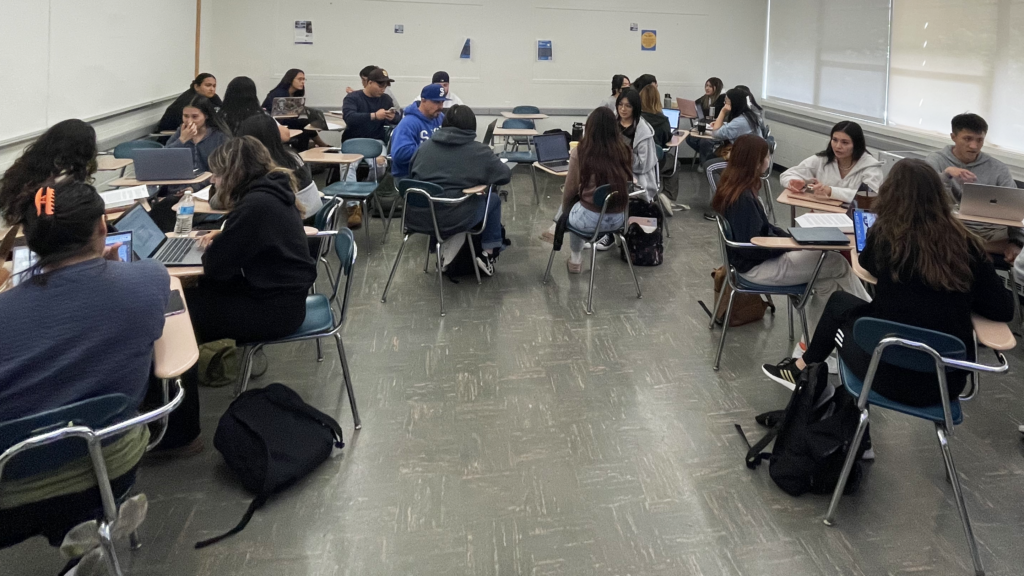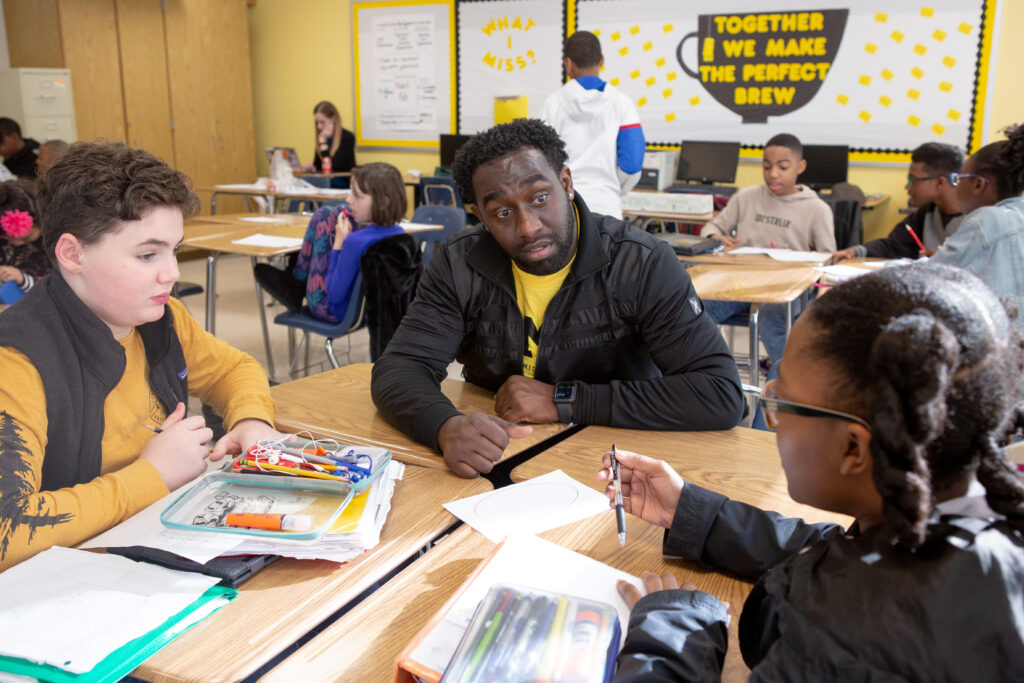
Students in Megan Thiele Strong’s Sociology of Higher Education work in small groups.
Credit: Courtesy of Megan Thiele Strong
We are in midterms — the season when many students realize their course participation is already subpar. Every semester, a handful of students in my courses do not “make it.” When grades are due, there are F’s.
The terrain of higher education is replete with obstacles. Many students are anxious and lack hope for their futures. California State University tuition hikes add to their unease.
Students are stressed. As professors, it is on us to help shift this dynamic in the classroom.
Last year, CSU dropped the SAT/ACT tests from its admissions criteria following research showing high-stakes exams are racist, classist, sexist and stressful. It is past time to integrate this approach into our schools and remove traditional high-stakes testing at the classroom level as well.
I have taught university-level courses to thousands of students in the University of California and CSU systems in my 15-year career. I currently teach several courses at San José State University, including a course on quantitative research methods.
In fall 2020, as we moved our courses online because of Covid, I was inspired to experiment, and I eliminated high-stakes exams, both midterms and finals in all my classes. I had been considering this shift for a long time as a way to mitigate harm and boost student investment. It felt like a big step. I could hear the critics: that eliminating exams caters to weakness, gives students a free pass, makes their education worth less. And yet, I knew I could rearrange the classroom from “teaching to the test” to teaching to the students in front of me. And, in so doing, also build marketable strengths like critical, analytical and creative thinking, leadership, curiosity and love of learning.
I also had a hunch that learning experiences such as orating course content are every bit as effective for knowledge retention as checking boxes and regurgitating the points of an essay response. Does every student pass my class? Nope. And, I have seen immense benefits since I transitioned away from high-stakes testing.
How do I prioritize the student over the exam?
First, I center dialogue in my teaching experiences. This oral engagement piece is worth nearly 20% of the student grade and I give time for it every class. It takes a variety of forms: I facilitate group conversation among students. I ask for volunteers to answer questions or discuss content with the group at large. Sometimes, I use a random number generator to call on students. Other times, I have every student answer a prompt to the full group. And, instead of student presentations, we do student facilitations where students create a version of chat stations with prompts and questions about the course content and facilitate a conversation with a small group of their peers.
I also create outside-of-class assignments, such as students hosting watch parties with a required post-viewing discussion segment or asking them to talk to someone about particular course content and report on it. The benefits of dialogue for our students and our society span educational, social and economic realms. I have found this approach helps students build their capacity for thought, engagement and discourse both in and outside the classroom.
Second, I adjusted my assessment strategy, moving from high-stakes exams to smaller, lower-stakes assessments; up to 35 graded learning experiences per student, per course, per semester. I incorporate content from my past exams into learning experiences, open-book quizzes and self-grade assignments. I construct my courses with varying levels of low-stakes opportunities for them to demonstrate proficiency in a topic — a video game mentality of earning points to level up, to build their investment in the course. It also makes it easier for the student — and professor — to spot gaps in understanding early, when there’s still time to address them.
Third, and following the logic that options boost student buy-in, I increase student choice in our curriculum. Where possible, students choose content. If there are larger edited volumes on a course topic, students choose the chapters they read. In Statistics, it’s choosing which graphs from The New York Times they want to analyze.
Fourth, I increase student agency by encouraging students to opt out of some of the curriculum. By constructing my courses with varying levels of low-stakes opportunities that build student buy-in, it feels responsible and empowering to make some content optional. As part of this strategy, I began to offer extra credit opportunities and other very low-stakes options, including learning experiences worth less than 1% of the total points.
Finally, and most importantly, having witnessed students in crisis over the years, and based on personal experience, I include content focused on student mental health. For example, I include optional student check-ins, where students can earn a few points by describing their experience both in and outside the classroom. I ask them, “Are you OK?” These experiences bring to the forefront how deeply valuable and vulnerable our classroom space is.
I trust my students, and I work to gain their trust not only by how I interact with them, but also through curricular decisions that constitute their classroom experience. Even if high-stakes testing is appealing to some students, even if it maintains a tradition that feels endemic to higher education, we know it devalues nontraditional student experience, perpetuates the wealth test as a proxy for merit, is a part of the racialized school-to-prison pipeline and is anathema to imagination.
Students are having learning experiences, for better or for worse, in our classrooms. Education should not be a burden to bear, a hazing experience, nor an obstacle to individual worth, even if that has been its tradition.
If the California State University system can forgo long-standing traditions of high-stakes assessment across 23 campuses, we can do it in our university classrooms.
•••
Megan Thiele Strong, Ph.D., is a professor at San José State University and a 2023-24 Public Voices Fellow at the TheOpEdProject.
The opinions expressed in this commentary represent those of the author. EdSource welcomes commentaries representing diverse points of view. If you would like to submit a commentary, please review our guidelines and contact us.


